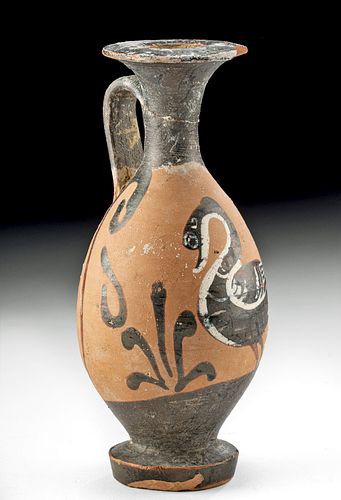Greek Black-Figure Lekythos w/ Swan, Pagenstecher Class
Lot 25
About Seller
Artemis Fine Arts
686 S Taylor Ave, Ste 106
Louisville, CO 80027
United States
Selling antiquities, ancient and ethnographic art online since 1993, Artemis Gallery specializes in Classical Antiquities (Egyptian, Greek, Roman, Near Eastern), Asian, Pre-Columbian, African / Tribal / Oceanographic art. Our extensive inventory includes pottery, stone, metal, wood, glass and textil...Read more
Categories
Estimate:
$2,500 - $3,500
Absentee vs Live bid
Two ways to bid:
- Leave a max absentee bid and the platform will bid on your behalf up to your maximum bid during the live auction.
- Bid live during the auction and your bids will be submitted real-time to the auctioneer.
Bid Increments
| Price | Bid Increment |
|---|---|
| $0 | $25 |
| $300 | $50 |
| $1,000 | $100 |
| $2,000 | $250 |
| $5,000 | $500 |
| $10,000 | $1,000 |
| $20,000 | $2,500 |
| $50,000 | $5,000 |
| $100,000 | $10,000 |
| $200,000 | $20,000 |
About Auction
By Artemis Fine Arts
Oct 8, 2020
Set Reminder
2020-10-08 10:00:00
2020-10-08 10:00:00
America/New_York
Bidsquare
Bidsquare : Exceptional Antiquities, Asian, Ethnographic
https://www.bidsquare.com/auctions/artemis-gallery/exceptional-antiquities-asian-ethnographic-5796
Museum-worthy examples of Egyptian, Greek, Roman, Etruscan, Near Eastern, Far East / Asian, Pre-Columbian, African / Tribal,Oceanic, Native American, Spanish Colonial, Russian, Fossils, Ancient Jewelry, Fine Art, so much more! Artemis Fine Arts info@artemisgallery.com
Museum-worthy examples of Egyptian, Greek, Roman, Etruscan, Near Eastern, Far East / Asian, Pre-Columbian, African / Tribal,Oceanic, Native American, Spanish Colonial, Russian, Fossils, Ancient Jewelry, Fine Art, so much more! Artemis Fine Arts info@artemisgallery.com
- Lot Description
Greece, Magna Graecia, southern Italy, Apulia, Pagenstecher Class, ca. 340 to 325 BCE. A charming lekythos (oil pouring vessel), with an oblong body that narrows to a cylindrical neck and flares to a flat rim, a strap handle joining neck to shoulder, all upon a discoid foot. A single large swan or goose standing in profile is rendered via the black-figure technique on the vessel body, with added fugitive white pigment outlining its open eye, contouring its form, and highlighting its feathers. A stylized palmette graces the area below the handle while tendrils and a rosette embellish the field. Size: 3.9" H (9.9 cm)
The swan played a complex role in Greek mythology - the attribute of Aphrodite and Apollo, said to sing a song of unearthly beauty as it dies, as well as the form assumed by Zeus to ravish Leda, mother of Helen of Troy. The latter, based on the writings of Ovid and Fulgentius, was well known in the European Middle Ages, and inspired artists, including Michelangelo, during the Italian Renaissance. However, the ancient Greek artisan who made this piece was probably depicting the swan as a general symbol of passion and beauty rather than a direct reference to the Zeus and Leda story. That subject gained its popularity later, because in Christian Europe it was more acceptable to depict women being intimate with a swan than with a man, while in ancient Greece there were no such restrictions.
According to the British Museum, the Pagenstecher Class referred to: "A group of 4th century BC vases (mostly lekythoi), collected by R. Pagenstecher early in the twentieth century and called by his name. These vases are unexpectedly decorated with the black-figure technique at a time when red-figure was the dominant technique in South Italy. The black-figure renaissance apparently took place in a number of centres, as most of the lekythoi were found in Campania and Sicily, while a few were also found in Paestum and Apulia. Sophisticated in style and relatively small in scale, most were decorated with only single figures, or a head or a bird."
Provenance: ex Estate of Eldert Bontekoe, Pegasi Numismatics, Ann Arbor, Michigan USA acquired before 2000
All items legal to buy/sell under U.S. Statute covering cultural patrimony Code 2600, CHAPTER 14, and are guaranteed to be as described or your money back.
A Certificate of Authenticity will accompany all winning bids.
We ship worldwide and handle all shipping in-house for your convenience.
#158860Spout reattached at the midline of the neck with some adhesive visible at the break line. Chips to rim and base as shown. Linear scratch to clay body along tendril beside the palmette below the handle. Normal surface wear commensurate with age, but the black-figure imagery is vivid with nice remains of fugitive white pigmentation.Condition
- Shipping Info
-
All shipping is handled in-house for your convenience. Your invoice from Artemis Gallery will include shipping calculation instructions. If in doubt, please inquire BEFORE bidding for estimated shipping costs for individual items.
-
- Buyer's Premium



 EUR
EUR CAD
CAD AUD
AUD GBP
GBP MXN
MXN HKD
HKD CNY
CNY MYR
MYR SEK
SEK SGD
SGD CHF
CHF THB
THB
















